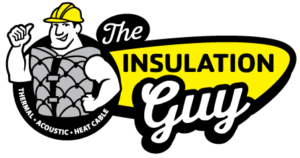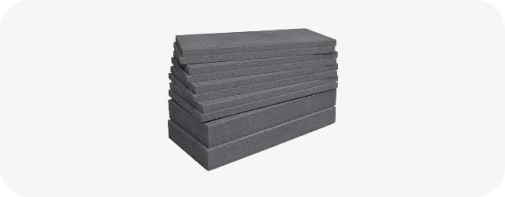Strength Properties
Kiilto construction adhesives is closely involved in the everyday work of construction professionals. With it’s solutions, it helps professionals to serve their own customers better than ever.

The short-term and long-term compressive strength of thermal insulation products used for inverted roofs, as frost protection on the ground, or to insulate slab-on-ground foundations must be reported, as the insulation products are subjected to particularly significant loads in these applications.
A long-term compressive strength test, i.e., a compressive creep test, conducted for a working life of 50 years will take 608 days, which is why a short-term compressive strength test is used in the industry as a rapid test. The short-term compressive strength can be determined by compressing the insulation 10% for a few seconds or by continuing to compress the insulation until the material fails. This test can also be used as a faster method for discovering the more important property of the insulation, i.e., its long-term compressive strength rating.
Structures must always be designed according to the long-term compressive strength, i.e., creep, which specifies how much the insulation will compress under the specific load. For example, the long-term compressive strength of FINNFOAM F-300 is reported as follows: CC(2/1.5/50)130, i.e., 130 kPa (approx.13 metric tons/m²). This means that under maximum load, FINNFOAM’s F-300 insulation will compress just 1.5% over 50 years.
The short-term and long-term compressive strength of thermal insulation products used for inverted roofs, as frost protection on the ground, or to insulate slab-on-ground foundations must be reported, as the insulation products are subjected to particularly significant loads in these applications.
A long-term compressive strength test, i.e., a compressive creep test, conducted for a working life of 50 years will take 608 days, which is why a short-term compressive strength test is used in the industry as a rapid test. The short-term compressive strength can be determined by compressing the insulation 10% for a few seconds or by continuing to compress the insulation until the material fails. This test can also be used as a faster method for discovering the more important property of the insulation, i.e., its long-term compressive strength rating.
Structures must always be designed according to the long-term compressive strength, i.e., creep, which specifies how much the insulation will compress under the specific load. For example, the long-term compressive strength of FINNFOAM F-300 is reported as follows: CC(2/1.5/50)130, i.e., 130 kPa (approx.13 metric tons/m²). This means that under maximum load, FINNFOAM’s F-300 insulation will compress just 1.5% over 50 years.
The short-term compressive strength is simply a feature and should not be used in design. Designs should be based on the long-term compressive strength, which can be used to calculate the maximum weight the product can be loaded with in long-term use.
Strength Properties Of Finnfoam
The lattice structure comprised of small cells extending throughout the entire panel makes FINNFOAM an extremely sturdy material. In addition, each side of the panel is covered by a solid skin that increases the rigidity of the panel as it creates a sandwich structure. The surfaces with high tensile strength and the core material with high compressive strength are attached securely to each other. The cell structure of FINNFOAM does not contain weak links, and there are now air channels or glue joints between the cells.
FINNFOAM’s long-term compressive strength in the standard panels (F-200–F-500) is 90–210 kPa, depending on the type of panel. The corresponding short-term compressive strength ranges from 200 kPa to more than 500 kPa. We can also produce F-700 panels with a short-term compressive strength that exceeds 700 kPa to order.
The grades/strength classes of frost insulation products are listed below:
F-200
The long-term compressive strength of F-200 exceeds 90 kPa, i.e., approx. 9 t/m2. F-200 was designed to be used as frost insulation and for insulating base floors in applications subject to load, but it can also be used for insulating walls and ceilings. F-200 is also excellently suited for use as a lightening material.
F-300
The long-term compressive strength of F-300 exceeds 130 kPa, i.e., approx. 13 t/m2. F-300 can be used for almost any application in detached houses. F-300 is also usually sufficient for frost protecting driveways and yards, where heavy traffic does not occur as such. F-300 is also sufficiently strong for installing under the foundations of lighter buildings, but F-400 or F-500 is generally used for heavier structures.
F-400
The long-term compressive strength of F-400 exceeds 180 kPa, i.e., approx. 18 t/m2. F-400 is used in areas with heavy traffic, such as highways, streets, and the yards of truck terminals. F-400 can also be used in parking lots where the insulation is not covered by a distributive layer of soil of at least 300 mm. F-400 is also generally used as a floor slab insulation in industrial facilities where the floor is regularly subjected to significant concentrated loads, such as trucks, forklift trucks, machinery, high storage shelves, etc.
F-500
The long-term compressive strength of F-500 exceeds 210 kPa, i.e., approx. 21 t/m2. F-500 is used for applications where high strength is required from the insulation, such as the frost protection of railways. F-500 is also used for the floors of industrial facilities with high pallet shelves or heavy machinery.
F-600 JA F-700
These are specialty products, which are available on order. These products are used for floors in industrial facilities, for example. Railways rated for higher than usual axle loads also utilize these extremely sturdy insulation products.








